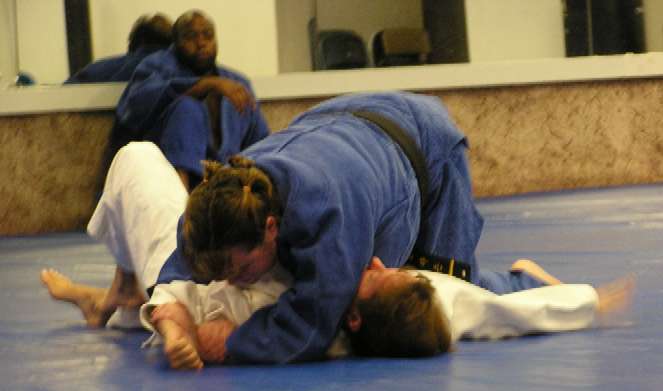Proper Etiquette
It is important to respect yourself, your
fellow students and your instructors. This respect involves
maintaining a certain level of etiquette during class. Most of
the following rules pertain to your safety and the safety of
your fellow students and are not optional. Judo is a full
contact sport, but is one of the safest due its rules.
-
When you first see Mr. Kim or another black belt, always bow and offer
a greeting.
-
Always answer instructors with
“Yes, sir/ma’am” or “No, sir/ma’am”.
-
Do not talk during presentations,
demonstrations or lectures by Mr. Kim or the other
instructors.
-
Stand unless instructed to sit. When
told to sit, do so in one of the two proper ways:
-
Do not leave the class without the
permission of Mr. Kim or an instructor.
-
Always be on time for class. If you
are late, enter the classroom and wait for Mr. Kim or an
instructor to speak with you. Then briefly warm up in the
back of the room and join the class.
-
Do not walk on the mats with your
shoes on.
-
No tobacco use or gum-chewing during
class.
-
Set mobile phones and pagers to
silent alert or turn them off.
-
Do not curse or use inappropriate
language.
Dress
-
Students should wear their judogi (judo uniform consisting of
trousers, jacket and belt) when practicing. It should always be clean and in proper order for each class with no
stains or tears.
-
Women: always wear a white, crew-neck, shortsleeve t-shirt or leotard
underneath the jacket. The shirt should be long enough to be tucked into the pants. Consider it as much a part of
your uniform as the pants, jacket, and belt.
-
Long hair should be tied back with cloth or elastic tie. No barettes or
ties with metal clasps or bands are permitted.
-
Remove eyeglasses and all jewelry. Piercings, necklaces, bracelets and
rings, which can wound you or your partner, must not be worn during practice.
-
Your personal hygiene should be conductive to physical training with
other students. Fingernails and toenails should be trimmed short.
Greeting a Black Belt or Beginning the
Class
Senior student says: “Charyeot!
Kyeongnye.” (pronounced: cha-ryawt! kyawng-nyay.)
Bow as you say: “Annyeong hasimnikka!”
(pronounced: ahn-yawng-ha-sim-nee-kah)
When beginning a class, the senior
ranking belt will call the class to attention and give the
command to bow. This is a formal way to say “hello” in
Korean and the bow is equivalent to a hand-shake. It is also
appropriate to acknowledge a Black Belt by bowing and saying
“hello” formally. If you see a Black Belt at a distance,
it is appropriate to bow without speaking.
Ending Class
Senior student says: “Charyeot!
Kyeongnye.” (pronounced: cha-ryawt! kyawng-nyay.)
Bow as you say: “Daedanhi
gamsahamnida!” (pronounced: day-dahn-hee-gahm-sah-ham-nee-dah)
When ending a class, the senior ranking
belt will call the class to attention and give the command to
bow. This is a formal way to say “thank you” in Korean.
This is how you with thank Mr. Kim and the other Black Belts
for their instruction. Mr. Kim will respond with “Cheonmaneyo.”
(pronounced: chawn-mahn-ay-yo). This means “you are
welcome” in Korean.
Formal and General Thank You
Bow as you say: “Gamsahamnida.”
(pronounced: gahm-sah-ham-nee-dah)
This is a formal way to say “thank
you” in Korean. Whenever Mr. Kim or a senior belt helps you,
it is appropriate to thank them in this way.
Bow as you say: “Gomapseumnida.”
(pronounced: go-mahp-sum-nee-da)
This is an informal way to say “thank
you” in Korean. When you finish practicing a technique, it
is appropriate to thank your partner in this way.
|